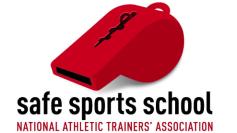Safe Sports School: What Does It Really Mean?
April 10, 2016
The National Athletic Trainers’ Association introduced the Safe Sports School award in an attempt to recognize outstanding athletic training programs in secondary schools. There are two distinctions that schools can qualify for: 1st Team and 2nd Team.
There are many criteria that must be met in order to become a Safe Sports School. Rather than me listing them one by one, I’ll instead refer you to the NATA website and the application (http://www.nata.org/sites/default/files/SafeSportSchoolAwardPacket.pdf). Instead I want to take the time to tell you what it really means to be a Safe Sports School. My employer, Bishop Lynch High School, became a 1st team award winner in January 2015. At the time, we were one of very few in the Dallas area to have achieved such status. For us as a private school, this was something we aspired to achieve as a recruitment tool specific to the sports medicine program. While our school is well-known in our area and region, this was a way for our specific program to stand out. 
Being a Safe Sports School means that we provide the best athletic healthcare for our student-athletes. At Bishop Lynch, our motto in athletic training is one that some of you already will recognize from me. Every Athlete Deserves an Athletic Trainer. But then we take that a step further with this additional sentence. Every Friar Athlete Has One. Under the direction of a sports medicine orthopedic surgeon, the Athletic Training Staff at BL consists of two Certified Athletic Trainers who are also licensed in the state of Texas. Additionally, BL employs a full-time school nurse along with a Student-Family Resource Counselor that is available as a counseling resource and advocate for the students. We consider our abilities on campus to work in conjunction with outside resources to provide for the very best care for all of our students. Each of our departments readily work together to achieve this.
Student-athletes undergo many health and medical changes over the course of their careers. For this reason, it is very important that routine medical examinations be performed so that the athletes may be screened for conditions that would warrant exclusion from athletics or adaptations. A thorough medical history and evaluation are important in this process. We require one each year they participate in athletics.
 Athletics carries an inherent risk of injury and sometimes those injuries may warrant emergency treatment. Our Athletic Trainers are present at all sporting events on our campus along with travel for some of our sports. We also regularly have a team doctor available to our student-athletes. Additionally, a thorough emergency action plan (EAP) is critical to the preparedness of our athletics programs. These procedures were written in conjunction with the security/safety staff on campus and the athletic department administration. It is important that the EAP in athletics is consistent and in line with the procedures in place on campus. This allows for consistent and streamlined operations in case of emergency.
Athletics carries an inherent risk of injury and sometimes those injuries may warrant emergency treatment. Our Athletic Trainers are present at all sporting events on our campus along with travel for some of our sports. We also regularly have a team doctor available to our student-athletes. Additionally, a thorough emergency action plan (EAP) is critical to the preparedness of our athletics programs. These procedures were written in conjunction with the security/safety staff on campus and the athletic department administration. It is important that the EAP in athletics is consistent and in line with the procedures in place on campus. This allows for consistent and streamlined operations in case of emergency.
With that, we also have emergency equipment available if the need arises. These may consist of AEDs, spine-board, vacuum splints, and other emergency equipment available to our medical staff.
Another component that a sports medicine team must address is the education of coaches, athletes, and parents. Educate them about a variety of injuries and conditions but also educate them on equipment safety, proper technique, and facility. But another critical component of education is to educate those individuals on the education, training, and background of the Athletic Training staff and sports medicine team.
We believe that being a Safe Sports School was a logical use of our money and it has raised awareness for our Sports Medicine program along with our school. We believe that it is our duty to provide for the health and wellbeing of the student-athlete and at Bishop Lynch we embrace that role and demonstrate this daily. I’m sure there are many schools across the nation who put safety first, like we do, and this award through the NATA is a way for those schools to stand out and show it. I encourage all Athletic Trainers to look at the criteria and evaluate your strengths and weaknesses. Maybe you aren’t ready to apply for the award, but maybe the information can allow you to make improvements to your program.
Every Athlete Deserves an Athletic Trainer. Every Friar Athlete Has One.